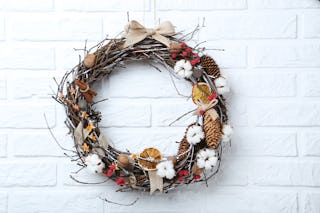
Deck the halls with boughs of holly, fa la la la la la la la la! Even in classic carols, Christmas wreaths are a big part of our holiday traditions!
We hang them on the doors of our homes, our churches, and our businesses. They’re a way to count down the days to Christmas, celebrate our religious beliefs, or even just show off what we’re interested in.
But have you ever stopped to consider how they became such a big part of our holiday traditions?

The History of the Christmas Wreath
The tradition really started with the Celts, who celebrated the Winter Solstice, also called “Yule”. They used boughs of holly to decorate their doors to celebrate the return of the sun or the birth of a god.
Round wreaths came into play in ancient Rome, where victorious warriors would wear wreaths or “coronas” on their heads as a symbol of honor. They would also hang them on their doors to show off successful battles. In Roman culture, women would wear wreaths (typically made of flowers and branches) on their heads for special occasions, like weddings.
Ancient Greeks also gave laurel wreaths to the winners of the original Olympic games.
christmas-wreath-made-by-florist

By the 1500’s, German Catholics and Protestants were using wreaths to celebrate Advent, the period leading up to Christmas Day. The idea to use candles as part of an advent calendar for kids came from a German pastor named Johann Wichern in the mid 1800’s. Each wreath had four candles nested in a circle of evergreens, with a fifth candle in the middle. Families and churches would light one candle each week leading up to Christmas, lighting the final, center candle on Christmas Eve.
For Christians, the circular shape came to symbolize the infinite love of Jesus and the creation of new life. Pagan wreaths represented the four elements – earth, wind, fire, and water.
Today, Evergreen wreaths are used all over the world, representing everything from the coming of Christ to the hope that life on earth never dies, despite winter winds and chills.
Fun fact: The word “wreath” comes from the old English word “writhen”, which means “to twist”.

The Symbolism of Christmas Wreaths
Christmas wreaths represent a lot of different things, depending on the way they’re decorated and the culture they’re found in. Take a look at some of the ways that people decorate Christmas wreaths and their history and meaning:
Evergreens
These are the traditional material used for wreaths. They’re used because they’re hearty and live through the winter. What great symbols of strength and immortality!Holly
Many traditional wreaths are also made of holly and include berries as well. The jagged texture of the holly leaves are thought to represent the thorns on Jesus’ head when he died on the cross, with the berries representing drops of his blood.Poinsettias
Often used in many ways during the Christmas season, they can also be used to create bright, impressive wreaths. The red flowers are thought to represent the blood of Christ.
Poinsettias, a red flower originally from Mexico, are commonly used as to decorate Christmas wreaths. Lavender
Wreaths made of this beautiful purple herb are traditionally found in the Alps. The purple colors represent friendship.Candles
These are traditionally lit as part of the advent calendar.Straw and Hay
In Poland (and other parts of the world), Christmas wreaths are made of straw and hay as a reminder of the Christmas manger.Fruit and Magnolia Leaves
These types of wreaths are very traditionally Southern. Colonial Williamsburg still decorates with magnolia and fruit wreaths every year.
Wreaths of dried wood, fruits and pine cones are a popular alternative to the classic greenery.
Christmas Wreaths Today
While Christmas wreaths are still used symbolically, especially in religious households, they’ve also become largely decorative. They’re an opportunity for each family or individual to show off their interests around the holidays!
You see creative wreaths everywhere, featuring sports, movies, the tropics, animals, hobbies, and more. Those that are crafty will make their own wreaths, which is a great opportunity to get kids involved! Some families will make photo wreaths, showcasing memories of Christmases past while others will use paper, felts and other craft materials.
One of the most recent Christmas wreath trends showcase bright colors – neon pinks, greens, and yellows – straying pretty far from traditional decor. These types of unique color palettes are becoming more and more common throughout Christmas décor!
And, of course, wreaths aren’t just used for Christmas! Now, you’ll find Thanksgiving wreaths, Easter wreaths, Halloween wreaths, and even wreaths for no specific holidays at all.
Fun fact: The red and green colors used for Christmas wreaths, trees, and other décor originated with the Winter Solstice use of holly and berries.